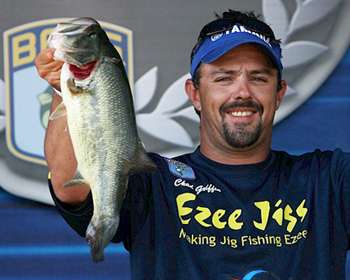
The side of Chad Griffin's wrapped boat reads "Ezee Jigs." That's the name of his lure company and also his main tournament strategy. Keep it simple, keep a jig in the water and let the good things happen.
For the weekend angler, it might not be so easy. A jig is a multipurpose lure, but there are various permutations, each of which has a specific role.
At the 2009 Elite Series final regular season tournament, which Griffin won on Oneida Lake, he complemented a topwater popper with a grass jig of his own making. His goal in designing the jig was to allow easy entrance and egress from the underwater vegetation. Accordingly, he relied on the image of the popular Texas rigged worm when he developed it.
"We basically tried to make a head as close to a Texas rig bullet weight as we possibly could," Griffin says. "You want the jig to slide into the grass and then, when you pull it back up, you don't want a lot of resistance coming back through the grass. You don't want to have to clean off your jig every time."
When fishing grass, Griffin starts with a heavier head than most anglers.
"The weight size is really critical," he says. "Sometimes you might not be fishing matted grass, but you still want that very fast presentation. At Oneida, the grass I was fishing was sparse, with clumps of it here and there. It was important to get my jig through the grass and generate a reaction strike."
"Most of the time if it's real shallow grass, like you might find along the bank, I'll usually start with a 5/8-ounce jig and work my way up to a 1- or 1 1/2-ounce head," he says. "For 8 to 15 feet of water, I'll usually start with a 1-ounce jig and go up from there. If I have to shake the jig to get it through the grass, I'll go even heavier."
Despite the oversized lead weight at the front of the jig, Griffin said even diminutive bass tend to bite. While a jig will often produce the biggest fish of a tournament, as was the case with Griffin's 5-8 Oneida lunker largemouth, it also catches its share of keepers.
Griffin believes that a small-profile jig provides the best way for the most fish to see his bait.
"With the Ezee grass jig, we've tried to make it more compact so the emphasis is on the trailer, rather than on the jig itself," he says.
When it comes to colors, he's typically trying to mimic baitfish.
"Most of the time when you're catching shallow grass fish, you're mimicking perch or bream," he claims. On a deeper bite, he'll focus more on the coloration of the local crawfish population.
The jighead color is typically not very ornate.
"I'm making it look as natural as I possibly can," he says. "I like to use the most basic color that I can find as long as it blends in with the skirt."





